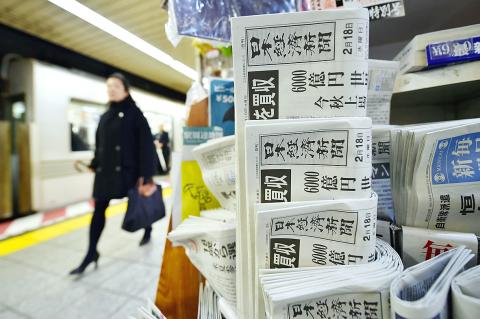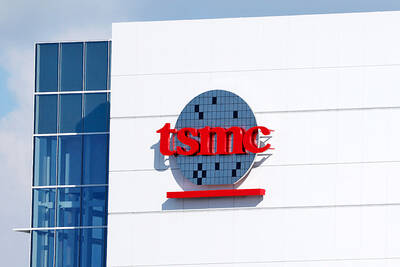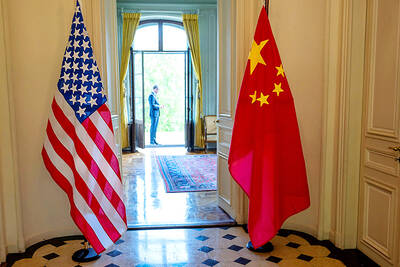Every morning, Japan’s most influential business daily, the Nikkei, supplies its 3 million readers with a host of market-moving news — from earnings to acquisitions — with crystal-ball-like accuracy.
Stocks rise and fall on the Nikkei’s reports about Japan Inc, which are treated like gospel when trading on the world’s second-biggest equities market.
However, the consistently on-the-mark news has riled overseas investors, who say it gives their Japanese counterparts an unfair home advantage being many time zones ahead, and sparked calls for changes in legislation to provide a level playing field.

Photo: AFP
When the Nikkei’s unsourced reports say Toyota Motor Corp is going to triple production of fuel-cell cars, Sony Corp will cut 1,000 jobs or that Skymark Airlines is going bust, investors pounce on the news as though it came from the companies themselves.
And weeks before firms report their quarterly financial results, the Nikkei rolls out figures that are so accurate they often beat analysts’ forecasts. A predictable pattern follows: companies deny supplying the information or reject it outright, and say “it’s not something we’ve announced,” only to confirm it days, weeks or months later.
Skeptics are convinced it could only be insiders providing such accurate information, a practice that is far more rare in other major markets such as New York or London.
An earlier analysis by Bloomberg News, which competes with the Nikkei, found that of 45 articles analyzed that contained profit figures that preceded the formal release of results, 37 gave a number that was within 10 percent of the company’s result, or predicted a range that turned out to be correct.
They beat analysts’ estimates in 61 percent of cases.
“If the articles are wrong, investors are surprised and wonder why, but they don’t doubt the stories in general,” Myojo Asset Management chief executive officer Makoto Kikuchi said. “When they’re wrong, it may be because the information from the company is old, or the person leaking it didn’t have all the info.”
In response to questions about the Nikkei’s astonishing accuracy, the paper told AFP that “we don’t reveal how we investigate stories.”
For its part, the Tokyo Stock Exchange says it is powerless to do anything unless there is proof of insider trading.
“All we can do is to ask companies to make [information] public as soon as possible,” a bourse spokesman said.
Other media are left bemused about where the Nikkei got its information while US and European investors complain it leaves them out in the cold, unable to immediately access the Japanese-language breaking news — despite more than half of Tokyo’s trading being done by foreigners.
“But nobody here seems to think it’s a bad thing,” says Nicholas Smith, a Japan strategist for brokerage CLSA, who calls the Nikkei reports a “pervasive and perennial problem.”
He said the practice was not likely to disappear, even as it does little to bolster the case for investing in Japanese firms.
“The [regulators] should strengthen the legislation around fair disclosure and it has to be rigorously enforced,” he said. “Japan has never managed to create a market culture — and there is still a lot of suspicion about how [the market] functions.”
Rules about firms disseminating information as widely as possible only date from 1999 in Japan, and a former chief of a large firm said companies sometimes confirm information collected by an army of Nikkei reporters, who hold regular meetings with company executives.
“This is THE newspaper of record so giving the information isn’t considered a leak,” he said.
The practice remains in place despite Japanese Prime Minister Shinzo Abe’s attempts to lure more foreign investors as part of a wider bid to kickstart Japan’s long-tepid economy.
Among the measures is a pledge to shake up the country’s governance standards, including mandating that more independent directors sit on companies’ boards.

Real estate agent and property developer JSL Construction & Development Co (愛山林) led the average compensation rankings among companies listed on the Taiwan Stock Exchange (TWSE) last year, while contract chipmaker Taiwan Semiconductor Manufacturing Co (TSMC, 台積電) finished 14th. JSL Construction paid its employees total average compensation of NT$4.78 million (US$159,701), down 13.5 percent from a year earlier, but still ahead of the most profitable listed tech giants, including TSMC, TWSE data showed. Last year, the average compensation (which includes salary, overtime, bonuses and allowances) paid by TSMC rose 21.6 percent to reach about NT$3.33 million, lifting its ranking by 10 notches

Popular vape brands such as Geek Bar might get more expensive in the US — if you can find them at all. Shipments of vapes from China to the US ground to a near halt last month from a year ago, official data showed, hit by US President Donald Trump’s tariffs and a crackdown on unauthorized e-cigarettes in the world’s biggest market for smoking alternatives. That includes Geek Bar, a brand of flavored vapes that is not authorized to sell in the US, but which had been widely available due to porous import controls. One retailer, who asked not to be named, because

SEASONAL WEAKNESS: The combined revenue of the top 10 foundries fell 5.4%, but rush orders and China’s subsidies partially offset slowing demand Taiwan Semiconductor Manufacturing Co (TSMC, 台積電) further solidified its dominance in the global wafer foundry business in the first quarter of this year, remaining far ahead of its closest rival, Samsung Electronics Co, TrendForce Corp (集邦科技) said yesterday. TSMC posted US$25.52 billion in sales in the January-to-March period, down 5 percent from the previous quarter, but its market share rose from 67.1 percent the previous quarter to 67.6 percent, TrendForce said in a report. While smartphone-related wafer shipments declined in the first quarter due to seasonal factors, solid demand for artificial intelligence (AI) and high-performance computing (HPC) devices and urgent TV-related orders

MINERAL DIPLOMACY: The Chinese commerce ministry said it approved applications for the export of rare earths in a move that could help ease US-China trade tensions Chinese Vice Premier He Lifeng (何立峰) is today to meet a US delegation for talks in the UK, Beijing announced on Saturday amid a fragile truce in the trade dispute between the two powers. He is to visit the UK from yesterday to Friday at the invitation of the British government, the Chinese Ministry of Foreign Affairs said in a statement. He and US representatives are to cochair the first meeting of the US-China economic and trade consultation mechanism, it said. US President Donald Trump on Friday announced that a new round of trade talks with China would start in London beginning today,